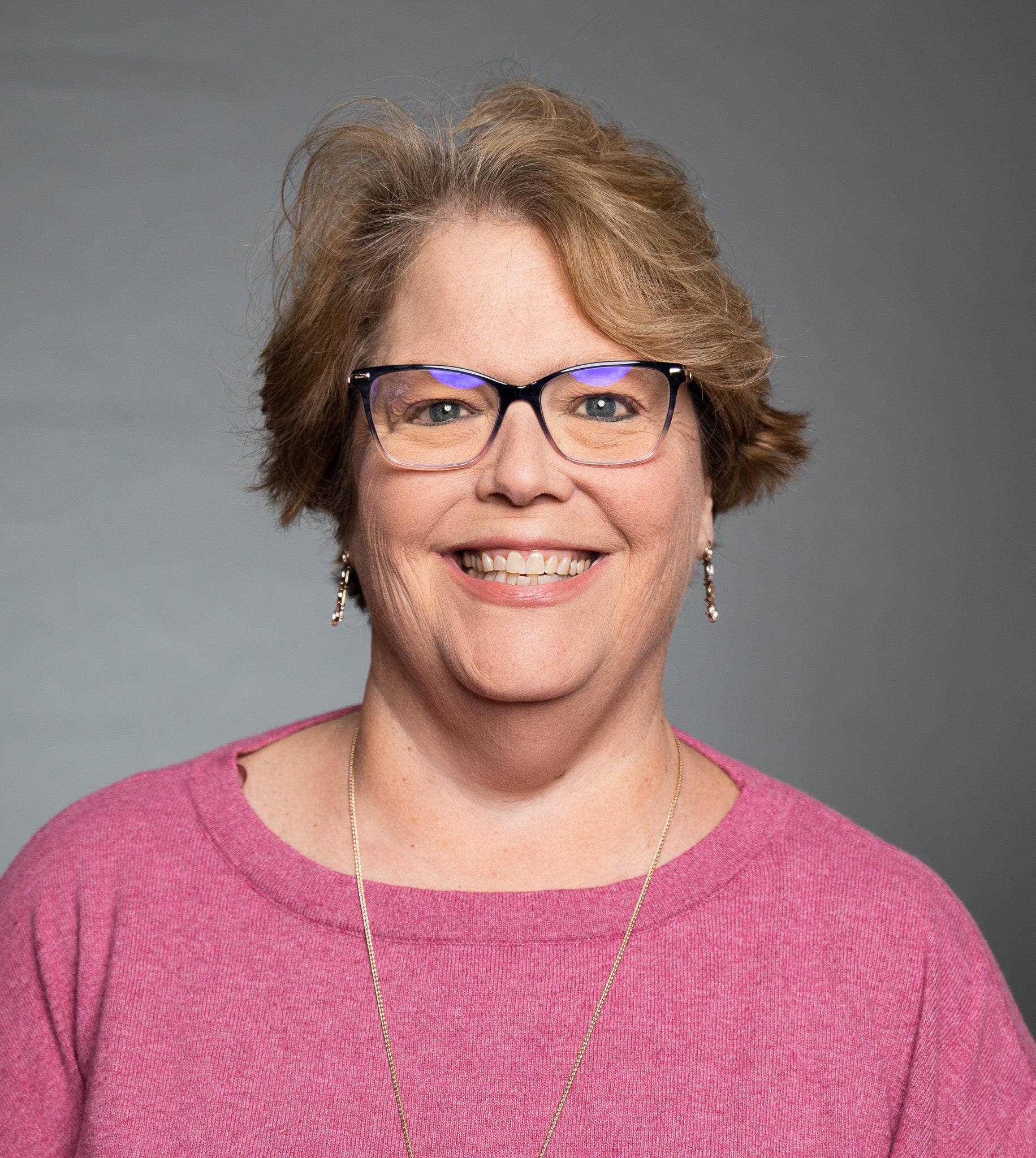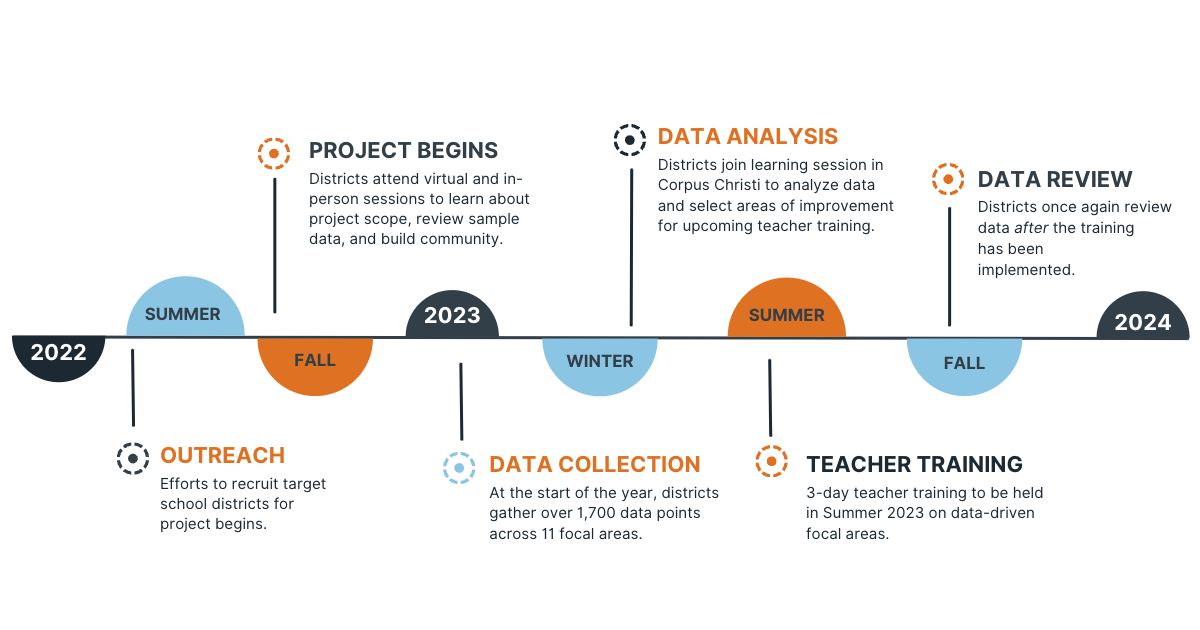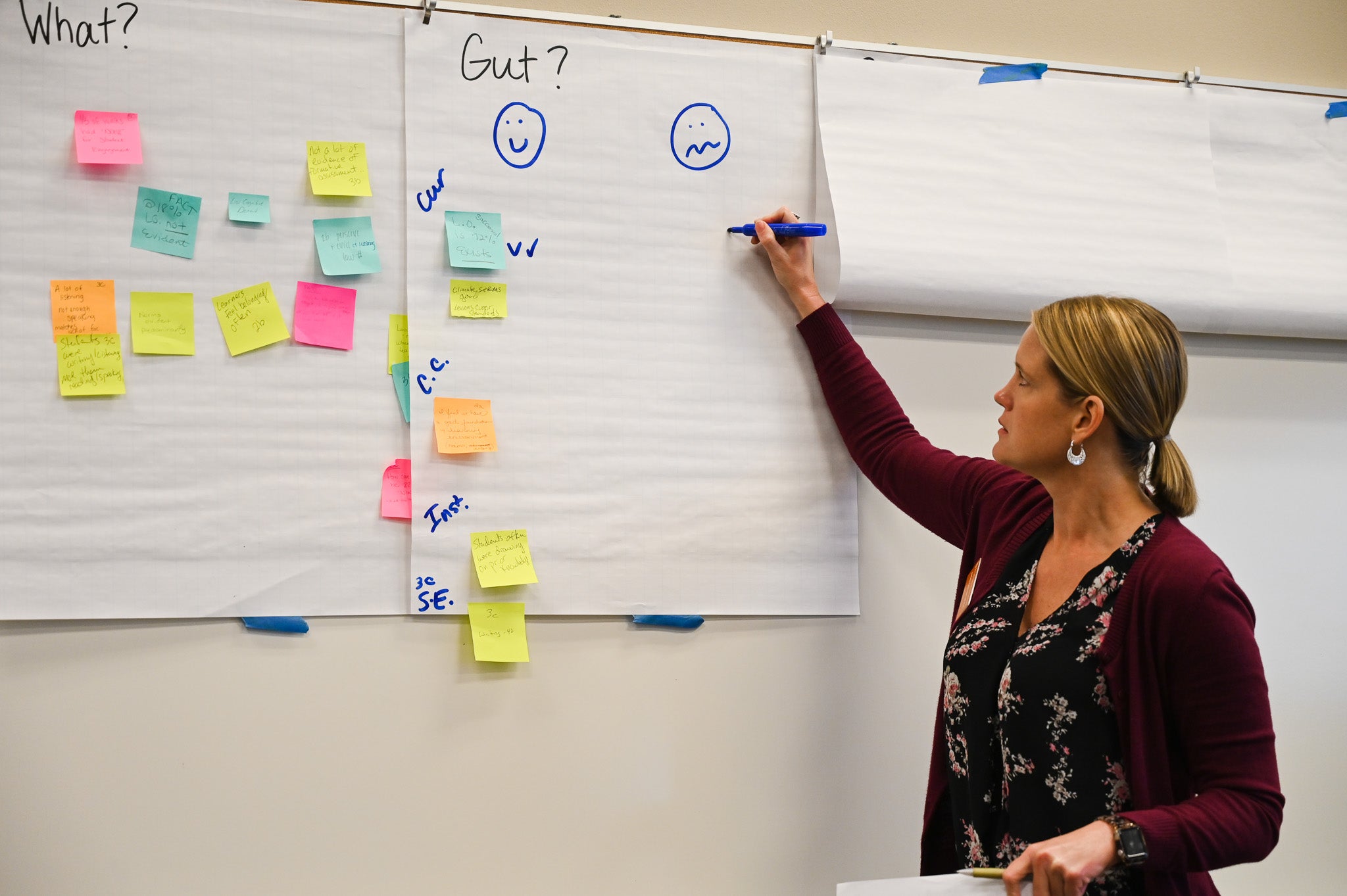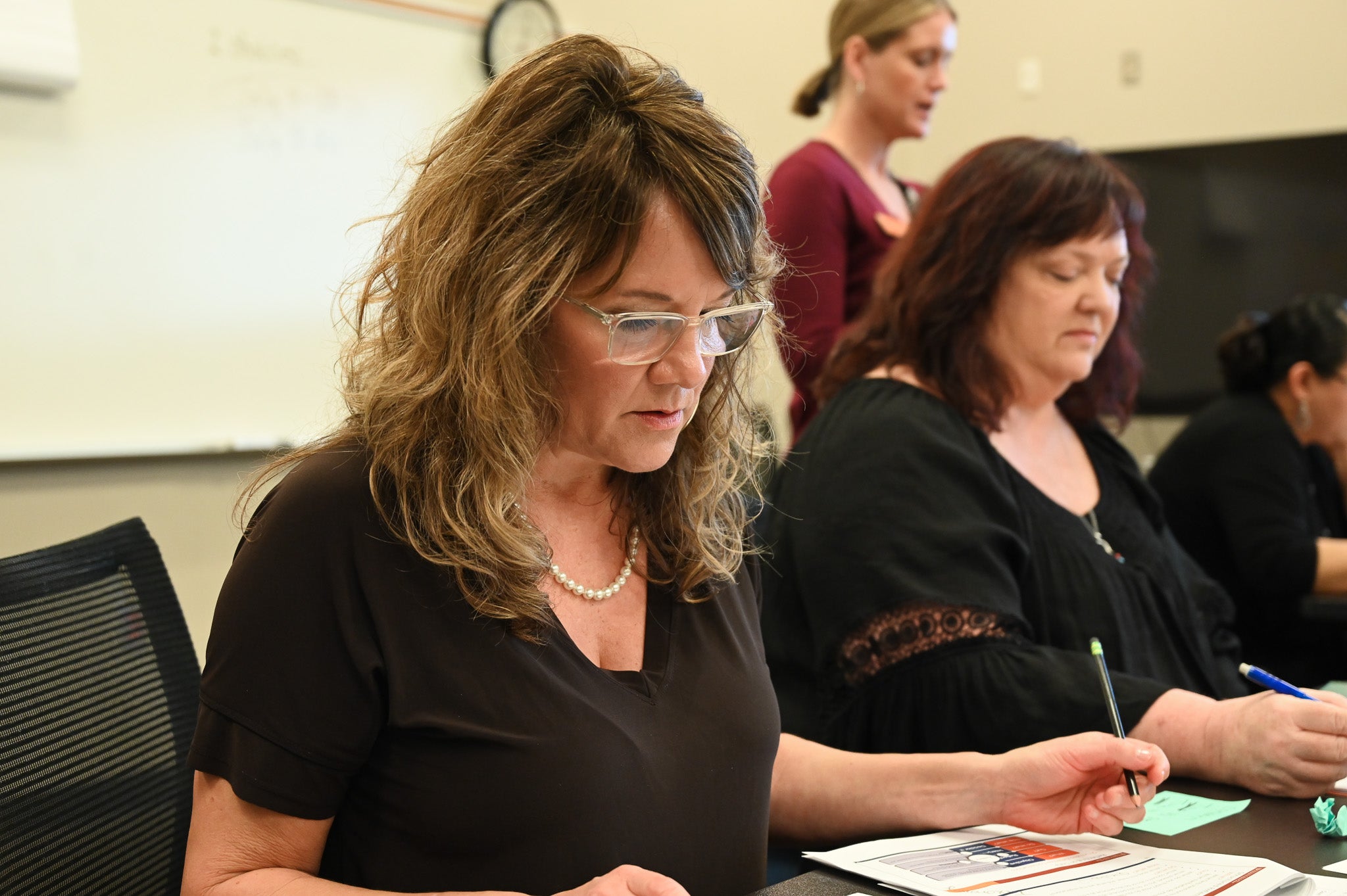
Paving The Way: The Rural School Network
Texas has the largest number of rural students in the United States. Representing about 37% of the state’s student population, rural students will play a crucial role in the Texas economy once they enter the workforce.
Despite their importance, rural schools are typically disregarded due to their small sizes and remote locations, disproportionately impacting Black, Latino, and economically disadvantaged students who make up most of their demographic.
To address this issue, the Charles A. Dana Center, through the support of the Greater Texas Foundation, developed a potential solution to tackle rural schools’ unique challenges. In 2022, the Rural School Network (RSN) began efforts to support targeted school districts in the Coastal Bend region where a high percentage of minoritized, specifically Latino, students reside.
Why Rural Schools Need Our Support
According to research findings from the REDEE Center at Texas State University that will be published later this year, passing Algebra 1 is a key indicator in determining students' overall success in school, including obtaining a high school diploma and pursuing higher education.
There are many reasons why students may not be successful in Algebra 1, but one interesting finding is the link between teacher preparedness and students’ passing scores. With teacher retention continuing to be an issue across the state, supporting and preparing teachers is a critical tool in helping students succeed, especially in rural school districts where teachers’ needs are often overlooked.
Passing Algebra 1 influences postsecondary outcomes, which is why RSN focuses on increasing teacher preparedness to help students successfully pass Algebra 1, graduate, and pursue a postsecondary education.
If we are serious about reaching our state’s postsecondary and workforce development goals, we have to ensure we are supporting students from all backgrounds to reach their full potential. This is why we are excited to support the Dana Center's Rural School Network project,” said Sue McMillin, president and CEO of the Greater Texas Foundation.
Setting students up for success means ensuring they have access to high-quality math courses. When these courses are taught by fully supported educators, student achievement is reinforced, enabling social and economic mobility.
Project Overview
RSN supports rural leadership and educators with data-driven tools to foster growth in their math departments from the grassroots level.

Mary Davis, project lead and professional learning and implementation specialist at the Dana Center, scouted rural schools in South Texas to participate in the project.
The aim was to recruit and establish a network of rural districts that could work together on data-driven solutions to boost student success in mathematics.
“Getting rural schools to participate was harder than we ever anticipated,” said Mary. “If we got in touch with someone, it could be the superintendent, who is also the basketball coach, who is also the custodian on game night. [Leaders and educators in rural schools] wear many different hats and oftentimes don’t have the bandwidth to add ‘one extra thing.’”
 Despite the hurdles, six districts elected to join the initiative in 2022:
Despite the hurdles, six districts elected to join the initiative in 2022:
• Mathis
• Nixon–Smiley
• Skidmore–Tynan
• George West
• Refugio
• Premont
Mary dedicated the first half of 2023 to taking frequent road trips to South Texas where she worked directly with math teachers and leaders. She trained them on data collection techniques for upcoming professional learning (PL) sessions in March of the same year.

Measuring Success
The project’s goal is to help leadership and educators discover key issues of practice in math classrooms through the Classroom Practice Study (CP Study)—formerly Classroom Walkthrough Tool—a system-focused tool that is very different from traditional evaluation methods.
Rather than evaluating teacher performance, CP Study guides educators in assessing a given school, district, or in this case, a department, by collecting hundreds of data points. Once enough data are collected and aggregated, they are then reviewed by teachers and leaders in upcoming PL sessions.
“The growth from analyzing what works and what doesn’t work is analogous with the work you do with students,” said Mary at a PL session in Corpus Christi, Texas.
The types of data collected across classrooms focused on:
- Curriculum: surfaces misalignment between instruction and grade-level standards, including cognitive demand, as well as student knowledge of curriculum
- Classroom Culture: collects evidence of teacher and student practices indicative of a classroom culture that values shared learning
- Instruction: shows teacher and student practices indicative of a student-centered learning environment, as well as data regarding how students are engaging with the content
Power in Numbers

Reviewing network-wide data can be both empowering and distressing, but when participants engage in the CP Study process, they are guided to identify actionable, purposeful next steps.
“We’re not trying to fix everything. We want to be strategic. We’re here to identify the most important areas to work on without overwhelming teachers,” said Jackie LeJeune, Dana Center professional learning specialist, reminding participants at a PL session that they're analyzing their current state of instruction.
After evaluating district data, rural leaders and teachers settled on three focal areas—vertical alignment (coherence), discourse, and purposeful questioning techniques—for a three-day teacher summit in Summer 2023.
Unique Challenges at Rural Schools
Rural schools face a variety of challenges that can have a significant impact on students’ access to a high-quality mathematics education. Many of these challenges are shared with the education sector at large such as inadequate funding, teacher shortages, and increasing pressure to meet academic standards. However, through the Rural Schools Network (RSN), the Dana Center observed other challenges rural schools experience.
In this section, we share these challenges and the effect they have on students, teachers, and rural communities.
Teacher Shortages
Staff shortage is one of the biggest factors that effects rural schools in the Coastal Bend region. With high teacher turnover and continuous hiring cycles, it’s challenging for rural schools to build capacity when all moving parts are in constant flux.
This issue is compounded when educators take on overlapping roles, limiting their capacity to prioritize off-campus professional learning. In some cases, if more than one rural educator attends an assembly, there is no one else available to take the wheel.
As one participant put it, “I wish we could’ve gotten more people involved.”
Unstable Infrastructure
Unlike large school districts with thousands of students and dozens of teachers, rural math departments are often composed of two to four teachers total. The constant replacement of teachers makes it difficult for leadership to promote a stable career path. A district even went to the extent of referring to itself as a "teacher training site."
“I don’t know where the balance lies. I don’t know how to determine if the person I'm focusing on and developing is open to receive growth. We have to find a way to communicate potential and encourage progress,” said Maria Jimenez, assistant principal at Nixon–Smiley ISD, after attending a professional learning session.
As a consequence of limited staffing, classrooms are overloaded or underresourced. Some districts may not offer AP courses due to a lack of certified instructors. In other cases, AP classes are capped, significantly reducing the number of students who have access to advanced coursework because there are not enough staff to meet the demand.
Socioeconomic Factors
Socioeconomic factors such as funding, language barriers, and safety can also create unanticipated circumstances for schools in rural Texas.
In the Coastal Bend region, many rural school districts were previously funded by property taxes from oil refineries in the area. Following modifications to tax policies, rural schools faced significantly reduced budgets after large corporations were given refunds.
On another note, Texas has more than a million students who are English language learners, according to a 2019 report by the Texas Education Agency (TEA). This presents an additional difficulty to student learning and academic achievement.
Furthermore, the Uvalde school shooting impacted safety and security concerns in these remote areas with limited access to reliable internet and bandwidth, halting professional learning efforts during Spring 2022.
Lack of Anonymity
CP Study is most effective when the data points collected are unbiased towards the teachers or classrooms observed. However, anonymity can be difficult to achieve in a rural school with a math department of two or three people. As a result, objective data collection can be challenging to obtain, leading to inaccuracies in data that inform decision making.
“Having worked as a math teacher at a big school outside of San Antonio, which is roughly 4,500 students, you have no idea whose data you’re collecting because it’s a larger math department,” said Mary. That’s not the case in a rural school with data collected from two or three teachers.
There’s room for improvement when it comes to developing tools for schools with smaller math departments. Regardless, participating districts were responsive to a system-focused approach and were still able to capture their districts at a glance. As one participant said, “It helps a lot when you’re only looking at the instruction, and not the name on the paper.”
What Rural Schools Have on Their Side
Due to their smaller sizes, rural classrooms enable a learning environment where educators can provide more individualized attention and tailor the lesson to meet the needs of each student. They have a remarkable ability to optimize their resources and leverage their sense of community to propel students forward.
In this section, we explore the benefits of rural school and how they can support teachers in increasing mathematical success.
Positive Teamwork
The collaborative environment of the PL sessions welcomed open conversations about both the drawbacks and perks of working in rural school districts.
“It’s one thing to have someone present information to me, and it’s a whole different thing when I can brainstorm and talk to colleagues about what’s working and not working,” said Brandon Duncan, assistant director at Refugio ISD.
The interactive nature of RSN allowed regional leaders and teachers an opportunity to actively engage in the planning process, instead of merely listening to a presentation, as they were accustomed to doing. Since rural schools are often unable to regularly connect with other area schools, when there are opportunities to come together and learn with and from one another, these educators make the most of it.
Personalized Learning
Small schools offer a more personalized experience for students, thanks to the close relationships that teachers and administrators can form. In these environments, educators often know each student in a grade by name and may even know personal details, such as where the parents work or the number of siblings a student has.
“We know our students,” said Amy Piña, instructional coach at Nixon–Smiley ISD. “We get to watch them grow up from second grade math to Algebra 1, and we did that.”

Supportive Workplace
Despite high teacher turnover, the faculty have found a way to coordinate seamlessly to make the most of their available resources.
“Our math department works very well together. There’s four of them and when one teacher is out, the other takes over. They know each other’s classes and they’re always ready to go,” said Maria Jimenez, assistant principal at Nixon–Smiley ISD.
The Road Ahead
The Rural School Network is an example of how much rural schools value data-driven processes that increase equitable access to a high-quality math education.
While challenges remain, the Dana Center and funders like the Greater Texas Foundation must continue to support and invest in these small but mighty districts. As Mary Davis wisely said to a group of rural educators, “You are teaching as if you were an island, but within 10 miles, you have a district going through the same things. That’s the power of this — you’re not alone.”
By working together and sharing knowledge, rural communities can build a strong and robust mathematics program that meets the demands of the future.
“This isn’t the end all be all. What we don’t have, we can have,” said Maria Jimenez, assistant principal at Nixon-Smiley ISD.
Through the Rural School Network and beyond, the Dana Center will continue to advance mathematical success for students across the country, ensuring that a student's zip code does not determine their destiny.
About the Author
Genesis Moreno
It’s been both a challenge and an incredible joy to discover the right combination of words to share an idea. Dedicating my career to exploring creativity has led me to meaningful work that empowers others. Working at the Charles A. Dana Center is where my passion for purpose and creativity meet.
Subscribe to our Newsletter
Sign up to our newsletter to be the first to know about Dana Center news and access free resources!

